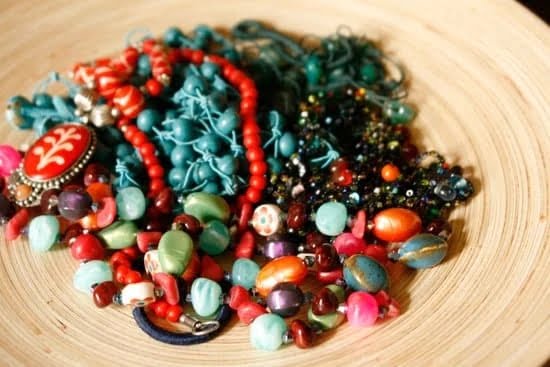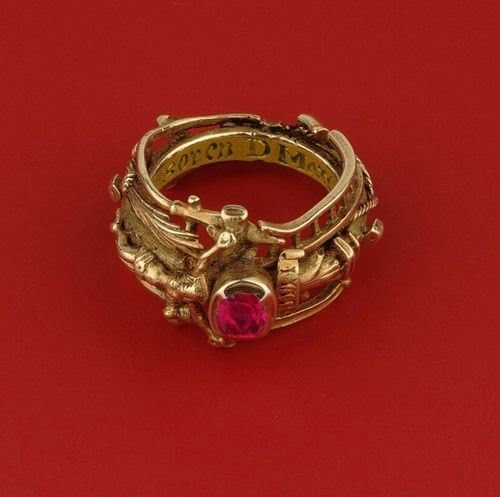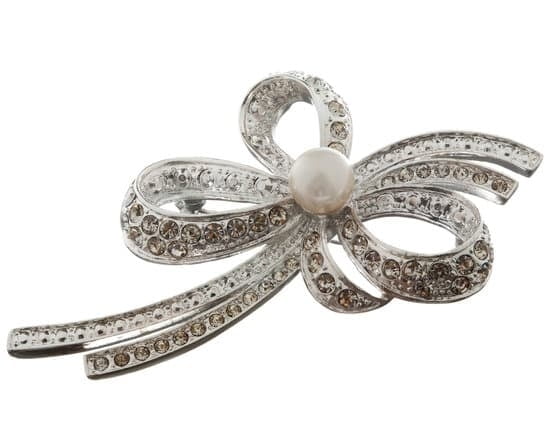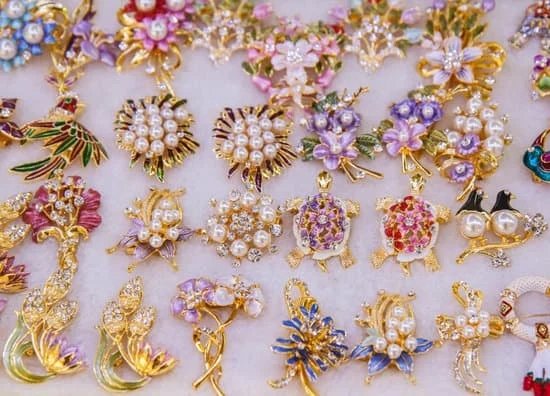Hydrogen Peroxide Jewelry Cleaning is a process of cleaning jewelry which uses hydrogen peroxide as the main ingredient. It is a mild method compared to others, making it safe to use on all types of jewelry. This type of cleaning is particularly effective for deeper cleanings, and can quickly restore luster and shine to dull jewelry pieces.
The process begins with jewelry items being immersed in a 10 percent solution of hydrogen peroxide mixed with water for up to two hours. The oxygen molecules in the solution help break down any dirt or oil that may have built up on the surface over time.
After this, the items can be gently buffed and polished with a soft cloth or cotton ball to remove any residue and get back their original shine. The result should be a sparkling piece of jewelry that looks like new again.
Benefits of Hydrogen Peroxide Jewelry Cleaning The main benefit of hydrogen peroxide jewelry cleaning is that it’s much gentler than harsher cleaning supplies which could potentially damage fragile stone settings or other delicate parts like clasps and earring posts. It’s also safe enough to use on even older pieces, so you don’t have to worry about aging gold or silver getting too weakened from harsh chemicals.
Plus, it won’t leave behind any smudges or streaks-just perfectly clean jewelry. Using this method regularly will help keep your jewelry looking its best and can extend its lifespan significantly.
Advantages and Disadvantages of Hydrogen Peroxide Cleaning
Hydrogen peroxide has emerged as one of the most popular DIY jewelry cleaning solutions and for good reason. This simple solution can help restore your favorite jewels to a like-new shine without requiring any special equipment. But while effective, there are some things to consider before opting for this type of cleaning:
Advantages
- Affordable – Hydrogen per oxide is readily available at almost any store, making it low cost.
- Easy to Use – No special skills or knowledge are required to use it.
- Eco-friendly – Hydrogen peroxide is considered an eco-friendly choice when compared to some other common jewelry cleaners that may contain harsh chemicals.
Disadvantages
- Wrong Concentration Levels – The concentration levels must be accurate for the best results. Too high levels can damage delicate jewelry pieces over time.
- Requires Patience & Time – Hydrogen peroxide needs more time than other cleaners because it doesn’t act as quickly on dirt and grime as chemical cleaners do.
- Painstaking – It can be labor intensive to scrub each piece of jewelry manually until the desired results are achieved.
Identifying Jewelry Types Compatible with Hydrogen Peroxide Cleaning
For those looking to safely and effectively clean jewelry, hydrogen peroxide is a good option. It can be used to remove dirt, makeup, oil, and grease from jewelry without damaging it. However, it is important to remember that only certain kinds of jewelry are able to withstand hydrogen peroxide cleaning.
Soft Metals
Soft metals such as gold and silver can easily be damaged by hydrogen peroxide cleaning. The chemical can react with the metal causing tarnish or discoloration over time. Therefore, it is recommended to use a gentler cleanser for these metals if they need to be cleaned.
Organic Jewelry Pieces
Organic jewelry pieces like camel bone, amber, coral, ivory or turquoise should not be cleaned with hydrogen peroxide because it may discolor or damage the material. Natural elements like these are more fragile than other materials so using a cleaner that is not harsh would be better suited for cleaning them.
Synthetic Jewels
Synthetic jewels such as fake pearls and rhinestones can safely be cleaned with hydrogen peroxide without fear of damage or discoloration since they don’t react negatively with the chemical solution in any way. To clean these pieces simply mix one part of hydrogen peroxide with two parts of water before soaking them for five minutes then pat them dry with a soft cloth afterwards.
How to Prepare Your Own Hydrogen Peroxide Jewelry Cleaner
Hydrogen peroxide is a natural cleaner that can be used to restore shine and sparkle to your jewelry. It is a safe, non-abrasive product and is often included in store-bought jewelry cleaning solutions. Here are some easy instructions for preparing your own Hydrogen Peroxide Jewelry Cleaner at home:
- Gather supplies. You’ll need hydrogen peroxide solution, an old toothbrush, baking soda, and a bowl.
- Mix equal parts hydrogen peroxide solution and baking soda into the bowl.
- Add enough water to the bowl so that the mix becomes a paste-like substance.
Now that you’ve made your own solution it’s time to start cleaning your jewelry:
- Submerge the piece of jewelry into the bowl of hydrogen peroxide mixture.
- Allow it to soak for 10 minutes.
- Remove the jewelry from the mix and use an old toothbrush to scrub away any dirt or residue.
If there are any hard-to-reach areas that need extra attention, you can make a paste from more hydrogen peroxide and baking soda. Dip a cotton swab in this paste and gently scrub these harder-to-get areas. Make sure not to rub too roughly though as this could damage the delicate finish of your jewelry. Once you’re done with all of those areas just rinse off your piece of jewelry with warm water.
Finally, pat dry your pieces with a soft cloth before storing them away. This will ensure that they retain their shine for years to come.
Step-by-Step Guide to Utilizing Hydrogen Peroxide Cleaner on Jewelry
Hydrogen peroxide cleaner is a great option for cleaning jewelry, as it quickly removes residue that accumulates over time. It is important to note, however, that this type of cleaner only works on non-porous materials such as silver and gold. The following steps will help you get the best results from your hydrogen peroxide jewelry cleaning efforts:
- Obtain a bottle of 3% hydrogen peroxide solution – these are widely available in most local pharmacies.
- Create a solution of one part hydrogen peroxide with one part water in a bowl or container large enough to submerge your jewelry.
- Once submerged in the solution, give the pieces time to soak for up to 10 minutes – longer if needed.
There are several tools that can assist with efficient cleaning. Use lint-free cloths or soft bristle brushes to gently rub away any oxidation product away from the metal without causing scratches.
Additionally, an ultrasonic bath may be used if available. To do so, submerge your jewelry piece into the machine’s tank filled with a diluted solution of hydrogen peroxide and distilled water (50/50), run it for three minutes and then rinse off the piece thoroughly with warm water before drying with a soft cloth.
- (a) Lint-Free Cloths
- (b) Soft Bristle Brushes
- (c) Ultrasonic Bath Fillled with 50/50 Solution of H2O2 & Distilled Water
After finishing up on the soiling process it is then recommended that you rinse off any residual cleaner from all surfaces using warm running water and pat dry with soft towels afterwards. In order to protect certain pieces against future staining or fading, it might be considered applying some clear lacquer onto them following a thorough drying process.
It is also advised to store silver jewelry inside airtight bags/containers when not being worn occasionally to prevent tarnishing; furthermore, general maintenance and care should be taken such as avoiding contact between metals of different types when storing away pieces after usage.
Preparation Tips for Your Jewelry After Cleaning
- Read and follow the instructions on the jewelry manufacturer’s packaging carefully before cleaning.
- When making a paste, use equal parts of baking soda and hydrogen peroxide.
- Gently scrub any discoloration at a 45-degree angle to avoid abrading delicate settings or scratches in gemstones.
Hydrogen Peroxide is an effective jewelry cleaner when used correctly. It can be used straight or mixed with baking soda to create a paste that works best for most pieces. Properly cleaning jewelry with Hydrogen Peroxide will make it brighter and extends its life significantly. Here are some tips to help you get the most out of your jewelry cleaning experience.
Before cleaning your jewelry, always read and follow the instructions on the packaging for best results. This will ensure that you are not damaging the piece by using unsuitable methods that could potentially weaken delicate stones or materials. For added protection, put a soft cloth, such as felt, under the piece to prevent scratching while it is being cleaned.
Once you have gathered all materials needed, mix together equal parts of hydrogen peroxide and baking soda to form a paste that can be applied directly to pieces with discoloration or tarnish. Gently rub the paste at a 45 degree angle to avoid scratching delicate settings or creating swirls in the metal surface due to overzealous scrubbing. Once finished, rinse off any remainingpaste with warm water before air drying for best results.
Finally, apply protective spray specially designed for fine jewelry if necessary after every wearing or prior to long term storage – this will help guard against tarnishing as well as skin irritation from exposure to metals like nickel or copper found in certain types of jewelry such as earrings or bracelets.
At Home Cleaning Vs. Professional Cleaning
For those that have a variety of jewelry pieces that could benefit from a good cleaning, deciding between an at home hydrogen peroxide cleaning solution and professional jeweler service can be a daunting task. On one side the quickness and convenience of an at home hydrogen peroxide cleaning is attractive. On the other, entrusting your delicate and valuable pieces to someone who’s had formal training in how to best manage these items suggests security in making the right decision.
To best determine which path to take it’s helpful to compare the pros and cons of each method. It’s important to keep in mind that material makeup, condition of jewelry and personal preference are also factors to consider when making this decision.
- Pros: Fast, easy, affordable,convenient, no appointment necessary
- Cons: Not everyone knows how to use the proper concentration or technique; damage can occur if mixed incorrectly.
- Pros: Professional expertise will help protect even delicate pieces; jewler can identify potential issues with metals/stones and advise accordingly; allows for more thorough clean
- Cons: Typically costs more; must make an appointment; time involved may be longer than hyrdogen peroxide route.
It’s critical to understand what type of cleaning is most suitable for each piece before proceeding since different materials require special care. Taking into consideration what includes a professional jewelry cleaning service versus simply giving your jewels an at-home dip with hydrogen peroxide is key when deciding between both options.
With many delicate pieces such as gemstones that require particular solutions or protective coatings after every cleaning involving strong chemicals like hydrogen perioxide professionl help should be sought out. With some simple bracelets or necklaces however just swirling them around in a gentle solution may be fine provided you trust yourself not too overdo it making a mistake while using too strong of a solution which could end up damaging your jewelry beyond repair.
Long-Term Care Tips for Hydrogen Peroxide Cleaned Jewelry
When it comes to ensuring your jewelry remains clean and sparkly, one of the most overlooked ingredients is hydrogen peroxide. Hydrogen peroxide offers a safe and effective way to keep your jewelry looking as good as new for years to come.
Before you attempt to use this method for cleaning your jewelry, make sure to read up on the material in question and whether the substance can handle hydrogen peroxide safely. Not every type of metal or gemstone will be suitable so always exercise caution when attempting to clean with a solution such as this.
In order to execute a hydrogen peroxide clean, you should first mix equal parts hydrogen peroxide with water in a bowl and stir until dissolved completely. Now place your jewels into the mixture for no longer than four minutes.
Carefully remove the item from the bowl with tongs and rinse off with warm water carefully not applying too much pressure or warmth since these actives could cause harm if applied too harshly or excessively. Once rinsed off, dry off thoroughly using a soft cloth and finally enjoy your shiny re-polished jewelry.
Hydrogen peroxide cleaning can be used on many different types of stones including sapphires, rubies, diamonds, emeralds and more but it’s worth mentioning that certain semi-precious stones may not respond well when combined with this solution so always double check before doping something potentially harmful. It’s also important to note that silver jewellery should never be cleaned using this technique as it can end up tarnishing terribly which will require professional attention or replacement altogether.
Storing one’s items following an effective hydrogen peroxide clean is essential too. Items should be wrapped in a soft cloth or kept in air-sealed bags when not being worn regularly as exposure t ooxygen over time can ruin even the strictest of cleansings done properly with experienced hands.
By storing one’s items correctly and periodically going through regular maintenance care utilizing only approved solutions such like we discussed today, you’ll ensure that your jewelry stays looking its best now and long into the future.
Conclusion
Hydrogen Peroxide jewelry cleaning is a great way to keep your jewelry looking its best. Unlike harsh cleaners such as alcohol, hydrogen peroxide provides a gentle and non-abrasive way of polishing jewelry. The cleaner is also affordable and not much is needed to get amazing results.
However, like many things, there are some disadvantages to using hydrogen peroxide for jewelry cleaning. To begin with, the effects of this cleaner can be quite unpredictable; certain stone settings and metals may react differently.
Due to this it is crucial that you test it first in an area that won’t be seen or, if on an item of greater value than a few dollars, don’t take the risk. As mentioned earlier, any hydrogen peroxide left on the surface will discolor fading during the oxidation process however as we have seen previously this can be prevented by removing the residue with a soft cloth or gentile brush after each use.
Overall, due to its affordability and gentle approach hydrogen peroxide has significant advantages as a jewelry cleaner and makes for one good option amongst many available on today’s market. It doesn’t contain toxic chemicals or irritants which makes it safe for both people and the environment while still achieving superb results when properly used.
With that being said it should only ever be used carefully with all instructions followed closely – never let it linger while liquid on your items or pieces may become irreparably stained or corroded over time. By following these tips using hydrogen peroxide will almost definitely make your jewelry sparkle.

Welcome to my jewelry blog! My name is Sarah and I am the owner of this blog.
I love making jewelry and sharing my creations with others.
So whether you’re someone who loves wearing jewelry yourself or simply enjoys learning about it, be sure to check out my blog for insightful posts on everything related to this exciting topic!





